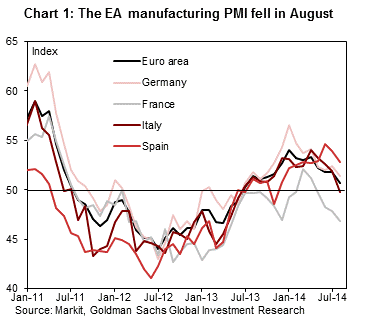If last week’s disappointing global economic data, that saw Brazil added to the list of countries returning to outright recession as Europe Hamletically debates whether to be or not to be in a triple-dip, was enough to push the S&P solidly above 2000, even if on a few hundreds ES contracts (traded almost exclusively between central banks), then the overnight massacre of global manufacturing PMIs – when not one but both Chinese PMIs missed spurring calls for “more easing” and pushing the SHCOMP up 0.83% to 2,235.5 – should see the S&P cross Goldman’s revised year end target of 2050 (up from 1900) sometime by Thursday (on another few hundreds ES contracts).
Some of the highlights, or rather lowlights: Dutch PMI 51.7, down from 53.5, Hungarian PMI 51.0, last 56.7; Spain PMI 52.8, Exp. 53.3, Last 53.9; Czech PMI 54.3, Exp. 55.5, Last 56.5; Swiss PMI: 52.9, Exp. 53.7, Last 56.5; Sweden PMI 51.0, Exp. 54.8, Last 55.1; Italy PMI 49.8, Exp. 51.0, Last 51.9 (back into contraction mode to go along the GDP decline and the record low inflation), French PMI 46.9, Last 46.5, Germany 51.4, Exp. 52.0, and Last 52.0 and finally the UK at 52.5, exp. 55.1, and last 54.8, was the lowest reading since June 2013.
Some more observations from Goldman: on Europe’s absolute manufacturing disaster:
The Euro area final manufacturing PMI printed at 50.7 in August, 0.1pt below the Flash and the consensus estimate (Flash, Cons: 50.8). This implies a 1.1pt contraction from the July print. The French component was revised up relative to the flash (+0.4pt), while the German component was revised down (-0.6pt). The August figure in both Italy and Spain showed continued loss of momentum, with the manufacturing PMI easing 2.0pt in Italy and 1.0pt in Spain relative to the July print (against a consensus expectation of a smaller decline).
- The Euro area aggregate Final manufacturing PMI printed at 50.7, 0.1pt below the August Flash owing to a considerable 0.6pt downward revision in Germany, outweighing a 0.4pt upward revision in France.
- The breakdown of the manufacturing PMI reflected the weaker headline print: New orders fell 1.4pt to 50.7 while stocks remained stable, thus implying a 1.3pt contraction in the forward-looking order-to-stocks ratio. Employment edged 0.6pt lower and remains relatively weak at 49.3. Output also declined by 1.7pt, now standing at 51.0.
- The Euro area manufacturing PMI now stands 5.7pt below the peak it reached in January. The manufacturing PMI for the Euro area is now roughly back to the levels seen around a year ago. That said, the PMI remains around 7pt above its low observed around mid-2012.
- Relative to the July print, the Final August manufacturing PMI shows a 1.0pt fall in both Germany (to 51.4) and France (to 46.9). The Italian manufacturing PMI fell by 2.0pt (to 49.8) against expectations of a smaller contraction (Cons: 51.0). The Italian PMI has eased 4.2pt since its recent peak in April, pointing to further weaknesses in Italian manufacturing activity. Its Spanish counterpart also declined by 1.0pt but remains a higher level of 52.8 (Cons: 53.3).
- Developments outside the major Euro area economies were mixed: the Dutch PMI declined 1.8pt (to 51.7). But the Greek PMI rebounded robustly by 1.4pt to 50.1 and the Irish PMI showed a strong gain of 1.9pt (to a very robust 57.3).


So in the aftermath of so much bad news which “guarantees” (at least according to the sellside penguinry) that Draghi will have no choice but to ease further this week, we are stunned to find Europe not hitting new record highs: according to RanSquawk, European equity markets trade in minor negative territory, as tentative sanctions risk and continued conflict in Eastern Europe sends stocks lower.

